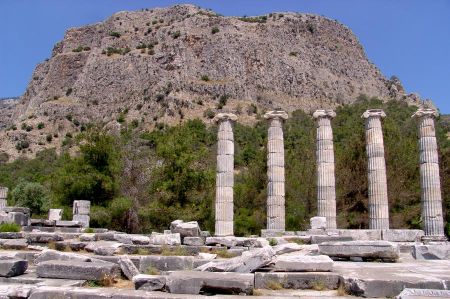Priene - Ancient City of Carian settlers
- Written by Portal Editor
Priene rises just behind the small town of Güllübahçe on the road from Söke to Milet and is one of the most magnificent and best-preserved cities of ancient Ionia and is one of the most beautiful archaeological sites and sights in the region.
The first settlement was founded in the 2nd millennium BC and moved to its current location in 350 BC. Priene itself was built according to the checkerboard pattern of the architect Hippodomus of Milet. Its original location is still not exactly known today. It is assumed that the name is of pre-Greek-Cretan origin, similar to Praisos and Priansos.
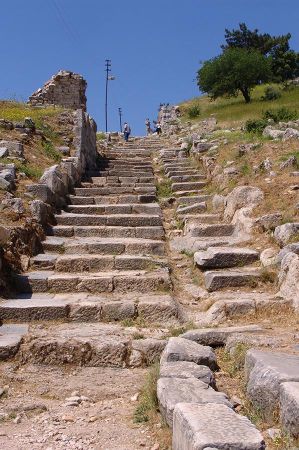 In the 4th century BC, Priene was a deep-sea port with two harbour basins and a view over the Bay of Milet and further east over the swamps of the Meander Delta. Although the area of Priene may have included part of the Meander Valley, agricultural resources were limited between the sea and the steep Mykale Mountain range.
In the 4th century BC, Priene was a deep-sea port with two harbour basins and a view over the Bay of Milet and further east over the swamps of the Meander Delta. Although the area of Priene may have included part of the Meander Valley, agricultural resources were limited between the sea and the steep Mykale Mountain range.
The Ruins of Priene
In recent years, the theory that Priene was one of the cities of the kingdom of Ahhiyava has gained weight. Pausanius reported that Priene was founded by Aipythos, son of Neleus of Athens and Philotas of Thevai. Strabo, on the other hand, described the city as being founded by Philotas and then called Kadme.
It is also believed that Priene (like Pitane, Myrina, Cyme and Ephesus) was founded by the queens of the Amazons.
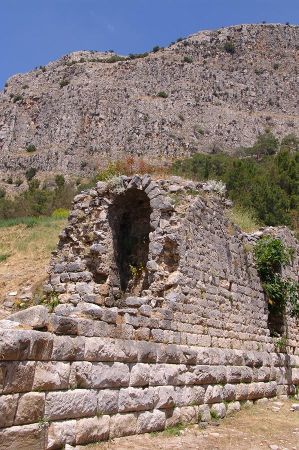 The only find that proves that Priene belonged to the Ionian League is an electrum coin discovered in Clazomenaea. This coin bears the head of Athena and could be dated to 500 BC.
The only find that proves that Priene belonged to the Ionian League is an electrum coin discovered in Clazomenaea. This coin bears the head of Athena and could be dated to 500 BC.
At the end of the 7th century BC, the city was founded by Aipythos, son of Neleus of Athens and Philotas of Thevai. In 545 BC, Priene was captured by the Lydians.
In the 6th century BC, Priene's golden age was over, as were all the other Ionian cities.
This era was ended in 545 BC by the commander of the Persian king Cyrus, Mazares, who captured the city. Priene took part in the Ionian Revolt - the Battle of Lades against the Persians.
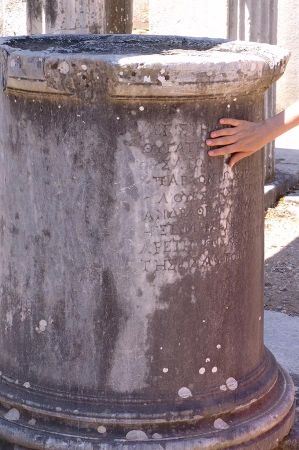 At the entrance to the ruins, the road on the right leads to the Priene Theatre.
At the entrance to the ruins, the road on the right leads to the Priene Theatre.
The theatre was built during the Hellenistic period and was modified during the Roman era. The theatre consists of 50 rows of seats and has a capacity of 5,000 people.
The orchestra area of the theatre has five marble seats that were reserved for the nobles.
The Sanctuary of the Egyptian Gods is located on the right side of the theatre. In front of the theatre is the Upper Gymnasium and on its side is the Byzantine Church.
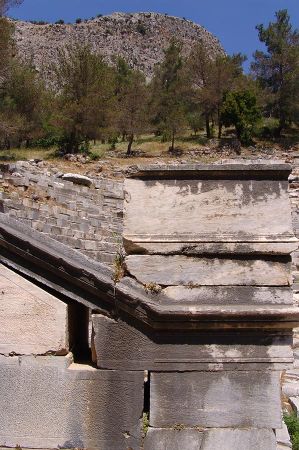 The Temple of Athena dates back to the 4th century BC.
The Temple of Athena dates back to the 4th century BC.
The architectural work was carried out by Pytheos, who also built the Mausoleum of Halicarnassus. The temple has 6 x 11 columns and the dimensions are 19.55 x 37.20 m.
Some of the columns of the temple were erected and are classic examples of Ionic architecture. The eastern half of the temple was completed by Alexander the Great.
In the past, the front altar was decorated with reliefs and is attributed to the 2nd century BC.
The colonnade, which shows a beautiful example of stonemasonry, is located to the south of the Temple of Athena.
A short break in between
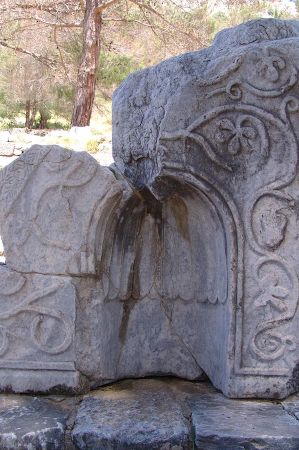 Also worth visiting is the restaurant with its own fish tank right next to the ancient aqueduct of the city, it is probably the oldest restaurant in this region, which offers its guests many types of freshwater fish, such as carp, for tasting. A well-deserved break from visiting the ruins. But now on.
Also worth visiting is the restaurant with its own fish tank right next to the ancient aqueduct of the city, it is probably the oldest restaurant in this region, which offers its guests many types of freshwater fish, such as carp, for tasting. A well-deserved break from visiting the ruins. But now on.
Below the temple you can see the Agora of Priene, which dates back to the 3rd century BC.
Next to it there was a fish and meat market. In the northern part of the Agora lies the sacred portico from the 2nd century BC.
The Bouleuterion (assembly house), which looks like a small square theatre, and measures 20 x 21 m and has a capacity of 640 people, is adjacent to the portico.
 Next to the portico is the Prytaneion (city hall) from the 2nd century BC, where the sacred fires used to burn. To the east of the Agora is the Zeus Sanctuary of Olympios.
Next to the portico is the Prytaneion (city hall) from the 2nd century BC, where the sacred fires used to burn. To the east of the Agora is the Zeus Sanctuary of Olympios.
There are houses on both sides of the street that connects the Agora to the West Gate.
The west gate side of the street is where the Sanctuary of Cybele and the House of Alexander the Great are located. Further south of Priene there is the Lower Gymnasium and the Stadium.
Please read as well:
Euromos the delightful City of Ancient Caria
Old Doganbey Village - Domatia
-
 Ancient City of Priene nect to Söke
Ancient City of Priene nect to Söke
Ancient City of Priene nect to Söke
Ancient City of Priene nect to Söke
-
 Ancient City of Priene nect to Söke
Ancient City of Priene nect to Söke
Ancient City of Priene nect to Söke
Ancient City of Priene nect to Söke
-
 Ancient City of Priene nect to Söke
Ancient City of Priene nect to Söke
Ancient City of Priene nect to Söke
Ancient City of Priene nect to Söke
-
 Ancient City of Priene nect to Söke
Ancient City of Priene nect to Söke
Ancient City of Priene nect to Söke
Ancient City of Priene nect to Söke
-
 Ancient City of Priene nect to Söke
Ancient City of Priene nect to Söke
Ancient City of Priene nect to Söke
Ancient City of Priene nect to Söke
-
 Ancient City of Priene nect to Söke
Ancient City of Priene nect to Söke
Ancient City of Priene nect to Söke
Ancient City of Priene nect to Söke
-
 Ancient City of Priene nect to Söke
Ancient City of Priene nect to Söke
Ancient City of Priene nect to Söke
Ancient City of Priene nect to Söke
-
 Ancient City of Priene nect to Söke
Ancient City of Priene nect to Söke
Ancient City of Priene nect to Söke
Ancient City of Priene nect to Söke
-
 Ancient City of Priene nect to Söke
Ancient City of Priene nect to Söke
Ancient City of Priene nect to Söke
Ancient City of Priene nect to Söke
-
 Ancient City of Priene nect to Söke
Ancient City of Priene nect to Söke
Ancient City of Priene nect to Söke
Ancient City of Priene nect to Söke
-
 Ancient City of Priene nect to Söke
Ancient City of Priene nect to Söke
Ancient City of Priene nect to Söke
Ancient City of Priene nect to Söke
-
 Ancient City of Priene nect to Söke
Ancient City of Priene nect to Söke
Ancient City of Priene nect to Söke
Ancient City of Priene nect to Söke
-
 Ancient City of Priene nect to Söke
Ancient City of Priene nect to Söke
Ancient City of Priene nect to Söke
Ancient City of Priene nect to Söke
-
 Ancient City of Priene nect to Söke
Ancient City of Priene nect to Söke
Ancient City of Priene nect to Söke
Ancient City of Priene nect to Söke
-
 Ancient City of Priene nect to Söke
Ancient City of Priene nect to Söke
Ancient City of Priene nect to Söke
Ancient City of Priene nect to Söke
-
 Ancient City of Priene nect to Söke
Ancient City of Priene nect to Söke
Ancient City of Priene nect to Söke
Ancient City of Priene nect to Söke
-
 Ancient City of Priene nect to Söke
Ancient City of Priene nect to Söke
Ancient City of Priene nect to Söke
Ancient City of Priene nect to Söke
-
 Ancient City of Priene nect to Söke
Ancient City of Priene nect to Söke
Ancient City of Priene nect to Söke
Ancient City of Priene nect to Söke
https://www.alaturka.info/en/turkey-country/aegean/2210-priene#sigProId3e657b9fbb
